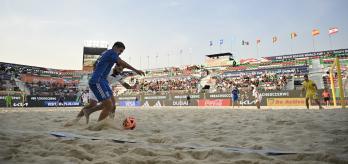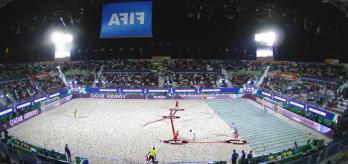After the first two rounds of the group stage, we saw 245 attempts at goal by bicycle kick, with 15 goals scored. A total of 40 of those attempts were blocked by defenders. In this article, Matteo Marrucci from FIFA’s Technical Study Group will explain the technical aspects of some of the most impressive blocks seen at FIFA Beach Soccer World Cup UAE 2024™ to date.
“Blocking the bicycle kick is a technical skill that in my experience as a player is underestimated. This skill is often not trained but is a skill that every player should be able to execute especially now when attackers can be needed for this type of defensive work. This should be coached and trained. The technique and the timing are so important because the bicycle kick is a protected movement. Once the attacking player has the ball under control, the defender cannot challenge so the last opportunity to defend a bicycle kick is to make a block,” he explains.
Key principles for blocking a bicycle kick
Marrucci was a renowned defender in his playing days, and now operating as a leading coach in the game, he gives his insights into the art of defending against this explosive action.
“From the point of the defender, you ideally want to be in front of the attacker so you can stop it at source. If the forward gets in front, and the ball is in the air, and he has already taken his touch to control it, the advice I give to my players is to take one step back. If you do this, you protect your position as a defender and reduce the risk of contact that can result in a foul being given against you. Then you must jump with perfect timing, and there are different styles and ways of jumping. In the clips below, we see some nice examples of the various types of blocks,” he added.
Jumping to block with your back
Jumping to block with your back is a trademark style of bicycle-kick blocks according to Marrucci.
“As we see in Clip 1 below, when performing this action, the defending player crosses their hands over their chest to avoid contact with the hands, but they must also make the full rotation to increase their body in the space. Colombia’s Edu López (5) does both really well in this example. As a defending player, if you are only side on when they execute the kick, there is more space either side of you for the ball to get through. This type of block applies when there is time to prepare for the block (i.e., the attacking player is taking one or more touches) and the defending player is close enough.
“When there is less time available the attempt to block becomes more instinctive. As can be seen in Clip 2, there is no time to stop the action because the attacking player’s first touch is already teeing up the bicycle kick. Here we see Brazil’s Diogo Catarino (4) jumping and turning very quickly in his successful attempt at making the block,” he explained.
The forward-facing ‘Ozu’ style block
Sometimes players opt to make the block when facing forward, towards the attacking player who is attempting the bicycle kick. In this instance, the defending player jumps and puts their head down to ensure any contact with their head is made with the strong forehead. A player who has been demonstrating this technique in Dubai is Japan’s Ozu Moreira (10), Golden Ball winner at the FIFA Beach Soccer World Cup 2019™.
Using Clip 3 below, Marrucci explains the technique involved.
“In this instance, Ozu stays facing forward so he can keep his eyes on the ball. When you jump and turn your back, you cannot see if the attacking player takes extra touches and could already have landed on the ground by the time he executes the kick. This way, Ozu can see everything. He ducks his head down to protect his face, but also his height gives him a good advantage in this situation, but all players (regardless of their height) will attempt this block.”
The foot block
Because of the acrobatic and explosive nature of the bicycle kick, sometimes defending this action requires an equally acrobatic and explosive reaction. This is where a last-ditch attempt is made to block a bicycle kick with a foot block. This type of block has a high level of difficulty from both the technical and physical perspective.
According to Marrucci, “You need to be extremely athletic and explosive to make this type of block successfully. The timing and execution must be perfect. This is used when a defending player is not close enough to make a normal block and by extending their foot/feet, they can potentially make contact with the ball. In Clip 4, we see a superb example of a foot block performed by Iran’s Amirhosein Akbari (2). Because he is not close enough to make an intervention with a back or a forward-facing block, and because he is coming in from the side, his only option is to attempt the foot block. The timing, accuracy and athleticism required to perform this type of block are very difficult to master and therefore need to be practiced.”
SUMMARY
Defending against a bicycle kick requires a dynamic and explosive response. Timing, athleticism, decision-making and courage are all required when performing the various types of bicycle kick blocks. These defensive actions are as much an art form as the bicycle kick itself and require significant practice to perfect.









